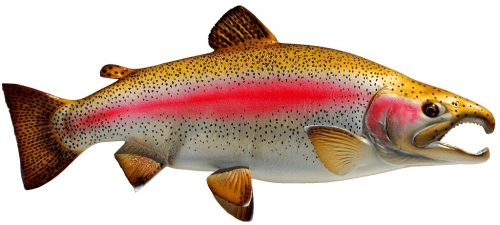Genetically speaking, steelhead and rainbow trout both pertain to the same species. However, differences in their migration, feeding, and spawning patterns resulted in notable changes in their appearance and characteristics.
This article provides the subtle differences between the two.
Summary Table
| Steelhead | Rainbow Trout |
| Anadromous form of Oncorhynchus mykiss | Resident form of Oncorhynchus mykiss |
| Migrates to the ocean before returning back to the freshwater | Stays in freshwater throughout its lifespan |
| Diet is mainly made up of salmon carcasses, small mammals, fish, and eggs | Diet is mainly made up of amphipods, squid, and other types of fish |
| Has a more diverse and complex life pattern | Has a simpler life pattern |
| Spends 2 to 4 years swimming in the ocean before returning back to its natal stream | Spends its entire life in small bodies of water |
| Undergoes the process of smoltification | Does not undergo the process of smoltification |
| Typically larger and slimmer | Body shape ranges from slender to thick |
| Distinct for its irregularly shaped dark spots and brassy or silvery color | Distinct for its intense pink stripes and heavily-spotted body |
| Higher chance of meeting potential threats | Lower chance of meeting potential threats |
Descriptions

The steelhead, also called steelhead trout, is a species named Oncorhynchus mykiss. A coastal rainbow trout in the anadromous form, the steelhead lives in the ocean for around 2 to 3 years before returning to freshwater to spawn.

Meanwhile, the rainbow trout, which is a species also called Oncorhynchus mykiss, is a trout that belongs to the salmonid family native to Asia, the Pacific Ocean, and North America. As a stream resident, the rainbow trout matures and spends its entire life in freshwater.
Steelhead vs Rainbow Trout
Although they are genetically the same species, there is a major difference between the steelhead and the rainbow trout.
Habitat
The steelhead and the rainbow trout pertain to the same species: the Oncorhynchus mykiss. However, changes in their habitat and migration patterns resulted in differences in their color, feeding habits, and characteristics.
The rainbow trout is considered the resident form since it stays in freshwater throughout its lifespan, while the steelhead is the anadromous form since it migrates to the ocean before returning to freshwater for spawning purposes.
Feeding Habits
Juvenile steelhead and rainbow trout school together and feed on larvae, aquatic insects, plant materials, and crustaceans. As rainbow trout mature, they move to larger bodies of water such as streams and lakes, where their diet is mainly made up of salmon carcasses, small mammals, fish, and eggs. Meanwhile, as steelhead migrate to the open ocean, they begin to feed on amphipods, squid, and other types of fish.
Migration Patterns
Between the two, the steelhead has a more diverse and complex life pattern. Unlike the rainbow steel that spends its entire life on small bodies of water, a juvenile steelhead spends its first few years on freshwater before migrating to open seawater. Typically, it spends 2 to 4 years swimming in the ocean before returning back to its natal stream for spawning purposes.
Physiological Changes
During their juvenile years, steelhead and rainbow trout look alike since they both live in freshwater. However, since steelhead migrate to the ocean, they need to undergo the process of smoltification, which is a series of physical transformation that enables a salmonid fish to adapt to seawater.
Smoltification involves changes in the skin, body shape, and gills.
Size
The body size of adult rainbow trout ranges from slender to thick. A steelhead, by contrast, is usually bigger overall but slimmer.
Color
The rainbow trout is distinct for its intense pink stripes and heavily-spotted body. An adult steelhead, on the other hand, is also heavily spotted, but unlike the resident form, it has irregularly shaped dark spots just above and under its lateral line. Although the color of a steelhead depends on factors like age and habitat, an adult steelhead is usually brassy or silvery in color.
Threats
The migration patterns of steelhead greatly affect their likelihood of meeting potential threats. Since the open ocean is home to larger predators, the number of returning adult steelhead is not always constant. Unlike the steelhead, the population of rainbow trout is generally stable.





